| Day 1 Beijing ( ) |
| Arrive at Beijing airport, be met & transferred to your hotel. Free at leisure for the rest of the day. |
| Beijing | As the center of politics, cultural and international exchange, Beijing is a modern metropolis full of vitality.
For the history buffs, Beijing is a living museum, but it has something to offer everyone. It is also the starting point for most of our China vacations. |
|
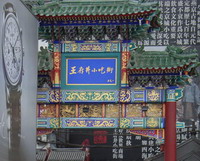 |
| [ Optional ] Wangfujing Streeet: It is the grandest shopping area in Beijing, congested with modern shopping malls, such as the Oriental Plaza, Wangfujing Department Store, etc. It is also home to a wealth of hotels and specialty shops. Around is an afflicted snack street where you can enjoy the most authentic Beijing snacks. |
|
| Day 2 Beijing ( B,L,D ) |
| Sightseeing tour with a private car with driver and a English speaking tour guide. Visit all must-see attractions in Downtown Beijing. At night, watch the famous Peking Opera, it is a kind of combination of arcobats, traditional singing and dancing performance. |
| Temple of Heaven | It was the place where the Emperor of the Ming and Qing dynasties would worship heaven and pray for good harvests. Built first in 1420, the Temple of Heaven is a precious example of China 's ancient architectural art and the largest design for worshipping heaven in the world. | | Tian An Men Square | As the largest city plaza in the world, it is of great cultural significance for its seeing of several key events in Chinese history. Today here are always sightseers and kite-flyers. Most visit at dawn or dusk to see the flag raising and lowering conducted by the PLA. | | Peking Opera | With a history of 160 years, Peking Opera, extolled as “Oriental Opera”, is representative of all operas in China. Full of Chinese cultural traditions and tidbits, the opera presents the audience with touching stories, beautiful paintings, exquisite costumes, graceful gestures and martial arts. | | Forbidden City | For almost 500 years, the Forbidden City served as the home of 24 Emperors and their households, and the ceremonial and political center of the Chinese imperial government. It was listed by UNESCO as a World Cultural Heritage Site in 1987. |
|
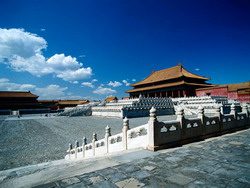 |
| [ Optional ] Forbidden City: For almost 500 years, the Forbidden City served as the home of 24 Emperors and their households, and the ceremonial and political center of the Chinese imperial government. It was listed by UNESCO as a World Cultural Heritage Site in 1987. |
|
| Day 3 Beijing ( B,L ) |
| The highlight today is the Great Wall. The Mutianyu Great Wall is less crowded than Badaling, you might walk up and down the Wall on foot, or take cable car one way or round trips. The extra cost of cable car (RMB 50 one way) will be at your own cost. |
| Sacred Way | It was originally built to lead to Changling Tomb as a symbol of the passed emperor’s journey to heaven in their afterlife. Alongside the Sacred Road are 12 pairs of animal marble figures such as lions, elephants and 6 pairs human marbles such as generals and public officials. | | Ming Tombs (Changling) | Changling Tomb is the largest and the most well-preserved one of the 13 Ming Tombs. Emperor Zhu Di, the third emperor of Ming Dynasty, and his Empress are co-buried in this grave. The 32 giant pillars in the Ling’en Hall, Changling’s main building, remain as solid as before after over 500 years. | | Mutianyu Great Wall | Mutianyu Great Wall seems to be not popular as section at Badaling, but it doesn’t get as crowded, which assist you in appreciating the magnificent scenery easily. Woods cover over 96% of the total scenic area, and its 2.5 kilometer stretch allows you a walk with striking landscape and fresh air. |
|
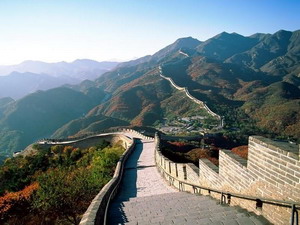 |
| [ Optional ] Dashilan old street: Dashilan is the oldest and perhaps one of Beijing’s most fascinating streets to explore. This district is cluttered South of Tian'anmen Square, it is the civilian area, known as the grassroots culture under the Forbidden City. |
|
| Day 4 Beijing, Xian ( B,L ) |
| Continue our tours in Beijing. Later transfer to Beijing airport for your flight to Xian. Upon arrival at Xian airport, pickup by our English speaking tour guide and drive to hotel. Free time for the rest of the evening. |
| Xiushui Street | Xiushui Street, also named “Silk Street”, is a shopping center in Beijing, with over 1,700 retail vendors. Although there are various goods in the market, the most attractive goods are silk. It's the bargain hunter's paradise, where you can purchase the top-quality goods with the lowest price. | | Hutong Tour | The Hutongs is the old narrow paths where common people used to live. You will be taken by rickshaws to visit ordinary Beijing families living in these compound houses. Rickshaws are actually three wheeled bicycles. There are fleets of them circling around the Hutongs. | | Summer Palace | The Summer Palace deserves your visit to her exquisite buildings, long corridor, and beautiful bridges. Her shoreline pathway makes an excellent run or walk for you. It was a luxurious imperial garden for royal families to rest and entertain in Chinese Qing Dynasty. | | Xian | Xi’an, named “Chang’an” in ancient time, is the ancient capitals of 13 dynasties, dating back to 3100 years ago. It’s the starting point of the Silk Road and honored as the World Historic City by UNESCO in 1981. Hence, it’s the first choice for those Chinese civilization lovers. |
|
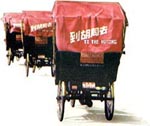 |
| [ Optional ] No 144 of Bei Yuan Men Folk House: Ancient-styled folk house in Muslim Quarter of Xian, mainly a brick and wood structure. It was listed as a "key project of Sino-Norway Historical Districts Protection" in 1999, and Norway Government is the sponsor that helped this cultureal program. |
|
| Day 5 Xian ( B,L ) |
| Visit the Terracotta Warriors and Horses Museum and Big Wild Goose Pagoda. |
| Xian Bell Tower | Built in 1384 A.D, the Bell Tower boasts a history of over 600 years. It is the largest and best-preserved of its kind in China. Visiting the Bell Tower, you can still see the Big Iron Bell which was made in Ming Dynasty, 2,500 kilograms in weight. | | Big Wild Goose Pagoda | It was built in 652 during the Tang Dynasty and currently boasts height of seven stories. It’s said that Master Xuan Zang built this pagoda to house the Buddhist scriptures and relics he had brought back from India. | | Terra Cotta Warriors and Horses Museum | Terracotta Warriors is the underworld terracotta army of Emperor Qin Shihuang (the first unifier of China, 259BC-210BC). It’s reputed as the Eighth Miracle of the World. Now the Terracotta Museum consists of Pit 1, Pit 2, Pit 3 and Pit 4 as well as the Hall of the two bronze chariots and horses. |
|
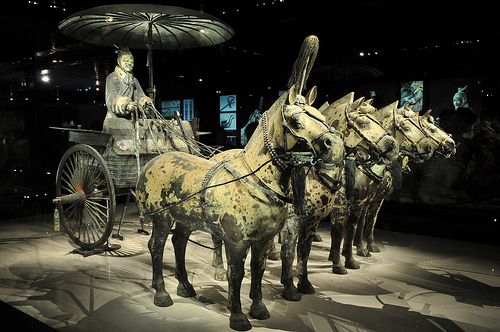 |
| [ Optional ] Tang Dynasty Dinner Show: The Tang Dynasty show has absorbed all the best music from the past dynasties and that of western regions and other countries. It vividly reflects their thriving economy, the friendly relationship between Tang and its neighboring countries, and the daily life of the Tang people. |
|